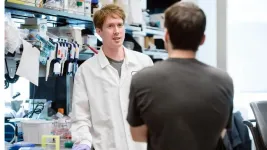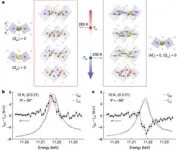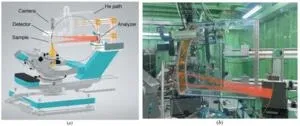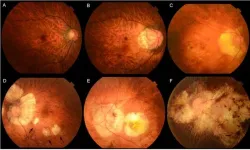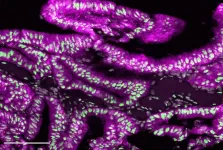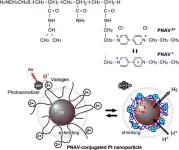(Press-News.org) SAN FRANCISCO—December 13, 2023—In a study of historic scale, scientists at Gladstone Institutes have created an intricate map of how the immune system functions, examining the detailed molecular structures governing human T cells using the next-generation CRISPR tool known as base editing.
Their findings, published in Nature, uncover detailed information that could help overcome the limitations of today’s immunotherapies and identify new drug targets for a wide range of diseases, including autoimmune diseases and cancer.
Led by Gladstone Senior Investigator Alex Marson, MD, PhD, the team dove deep into the DNA of T cells, pinpointing specific nucleotides—the basic units of genetic information in DNA—that influence how immune cells respond to stimuli. In all, they scrutinized more than 100,000 sites across nearly 400 genes found in functioning human T cells.
Nucleotides serve as the basic code for constructing proteins in cells, so by identifying these specific units of DNA the scientists now have clarity into exact locations within proteins that tune immune responses critical for health. The results serve as a bullseye, marking sites that can be targeted with future immune-modulating drugs.
“We’ve created astoundingly precise and informative maps of DNA sequences and protein sites that tune actual human immune responses,” says Marson, who is also director of the Gladstone-UCSF Institute of Genomic Immunology and the Parker Institute for Cancer Immunotherapy at Gladstone Institutes. “Our mapped sites provide insights into mutations found in patients with immune disorders. The enormous genetic dataset also works as a sort of cheat sheet, explaining biochemical code that will help us program future immunotherapies for cancer, autoimmunity, infections, and beyond.”
T cells play a central role in immune response and regulation, making them of keen interest to scientists looking to solve complex diseases such as cancer or immune disorders. For the past decade, the Marson lab and others have established the gene-editing technology CRISPR to study how primary immune cells work. For this study, the team went a step further, leveraging a newer CRISPR-based technology known as base editing to make more targeted changes to hundreds to thousands of DNA sites across individual genes—painting a much more nuanced picture at high-resolution.
Because the study was conducted using primary T cells sourced from human blood donors, results hold great clinical relevance, noted Ralf Schmidt, MD, co-first author of the paper. Schmidt, a medical fellow at the Medical University of Vienna, is a former postdoctoral researcher at Gladstone Institutes.
“This study is zooming into the genetic basis of immune cell functions,” Schmidt says. “We can now interrogate T cells at nucleotide resolution, generating blueprints for drug development, diagnostics, and further scientific endeavors.”
With immense pools of data generated from the more-than-100,000 sites on T cells, computational genomics became a critical piece of the study. Carl Ward, PhD, a Gladstone postdoctoral researcher and co-first author, led the team’s efforts in this area, keying in on important measures of cell function to create what he hopes can serve as an indispensable resource for immunologists and drug developers alike.
“We can now assign functions to specific mutations that had been a mystery,” Ward says. “Our detailed functional maps also can be combined with existing datasets and AI tools to amplify our discoveries and predict new avenues of investigation.”
Ward notes that the new Nature study is just the beginning of a new chapter of immune cell discoveries: “Our tools for solving disease are going to get better and better,” he says. “We’re nearing a point where we can use these maps to design therapies that can tune up the T cell function for cancer treatments or tune it down to treat autoimmune disease.”
About the Study
The paper, “Base editing mutagenesis maps functional alleles to tune human T cell activity,” was published in Nature on December 13. In addition to Alex Marson, Ralf Schmidt, and Carl Ward, authors are: Rama Dajani, Zev Armour-Garb, Mineto Ota, Vincent Allain, Rosmely Hernandez, Galen Xing, Laine Goudy, Charlotte Wang, Yan Yi Chen, Chun Jimmie Ye, Luke A. Gilbert, Justin Eyquem, Jonathan K. Pritchard, and Stacie E. Dodgson.
About Gladstone
Gladstone Institutes is an independent, nonprofit life science research organization that uses visionary science and technology to overcome disease. Established in 1979, it is located in the epicenter of biomedical and technological innovation, in the Mission Bay neighborhood of San Francisco. Gladstone has created a research model that disrupts how science is done, funds big ideas, and attracts the brightest minds.
END
Using next-gen CRISPR tool, Gladstone scientists create unprecedented molecular map of human immune response
Nature study represents a major stride for human genetics; findings will accelerate the development of new and better therapies for cancer and autoimmune diseases.
2023-12-13
ELSE PRESS RELEASES FROM THIS DATE:
Discovery of magnetic liquid crystal
2023-12-13
Liquid crystal is a state of matter that exhibits properties of both liquid and solid. It can flow like a liquid, while its constituent molecules are aligned as in a solid. The liquid crystal is widely used nowadays, for example, as a core element of LCD devices. The magnetic analog of this kind of material is dubbed the “spin-nematic phase”, where spin moments play the role of the molecules. However, it has not yet been directly observed despite its prediction a half-century ago. The main challenge stems ...
A rare enzyme role change with bacterial defense system assembly
2023-12-13
COLUMBUS, Ohio – Scientists have revealed a never-before-seen phenomenon in a protein: Alone, the enzyme processes DNA and RNA but, when bound to another protein as part of a defense system, interacts with a completely different type of compound to help bacteria commit suicide.
The finding came about as the researchers focused on detailing how this defense mechanism works in bacteria that are infected by phages, viruses that invade and make copies of themselves inside bacterial cells. In addition to detailing the proteins’ structures and binding sites, the experiments unearthed ...
Machine learning sees into the future to prevent sight loss in humans
2023-12-13
Researchers from Tokyo Medical and Dental University (TMDU) develop models based on machine learning that predict long-term visual acuity in patients with high myopia, one of the top three causes of irreversible blindness in many regions of the world
Tokyo, Japan – Machine learning has been found to predict well the outcomes of many health conditions. Now, researchers from Japan have found a way to predict whether people with severe shortsightedness will have good or bad vision in the future.
In a study recently published in ...
Scientists unveil complete cell map of a whole mammalian brain
2023-12-13
For the first time ever, an international team of researchers has created a complete cell atlas of a whole mammalian brain. This atlas serves as a map for the mouse brain, describing the type, location, and molecular information of more than 32 million cells and providing information on connectivity between these cells. The mouse is the most commonly used vertebrate experimental model in neuroscience research, and this cellular map paves the way for a greater understanding of the human brain—arguably the most powerful computer in the world. The cell atlas also lays the foundation for the development of a new generation of precision therapeutics for people ...
Cholesterol-lowering therapy may hinder aggressive type of colorectal tumor
2023-12-13
Hard-to-detect colorectal pre-cancerous lesions known as serrated polyps, and the aggressive tumors that develop from them, depend heavily on the ramped-up production of cholesterol, according to a preclinical study from researchers at Weill Cornell Medicine. The finding points to the possibility of using cholesterol-lowering drugs to prevent or treat such tumors.
In the study, published Oct. 13 in Nature Communications, the researchers analyzed mice that develop serrated polyps and tumors, detailing the chain of molecular events in these tissues that leads to increased cholesterol production.
They ...
Inequity in U.S. wildfire emergency response
2023-12-13
WASHINGTON, DC, 2023 – Recent U.S. wildfire events -- including the 2023 Maui wildfire in Hawaii, the 2022 Hermit’s Peak/Calf Canyon fire in New Mexico, and the 2020 Cameron Peak Fire in Colorado -- are tragic examples of how disadvantaged communities can suffer most during and after a wildfire. While all three fires had a devastating impact on an entire community, they disproportionately affected low-income populations who were left without adequate insurance or the financial means to rebuild their homes.
To study inequities in U.S. wildfire management, ...
When parents drink during Super Bowl, kids get harsh discipline
2023-12-13
COLUMBUS, Ohio – Parents who drank alcohol while watching the Super Bowl were more likely than those who abstained to use aggressive discipline on their children during the game, a new study shows.
Most of the parents in the study – more than 90% - were mothers, which is significant, said Bridget Freisthler, lead author of the study and professor of social work at The Ohio State University.
“The links between alcohol use, aggression and watching violent sports have been studied almost exclusively among ...
Reported drug use among adolescents continued to hold below pre-pandemic levels in 2023
2023-12-13
The percentage of adolescents reporting they used any illicit substances in 2023 continued to hold steady below the pre-pandemic levels reported in 2020, with 10.9% of eighth graders, 19.8% of 10th graders, and 31.2% of 12th graders reporting any illicit drug use in the past year, according to the latest results from the Monitoring the Future survey. Reported use for almost all substances decreased dramatically between 2020 and 2021, after the onset of the COVID-19 pandemic and related changes like school closures and social distancing. In 2022, most reported substance use among adolescents ...
Study: digital leisure reading does little to improve reading comprehension for students
2023-12-13
Washington, December 13, 2023—For years, research showed that print reading, whether for leisure or school, improved developing readers’ ability to comprehend text. However, the explosive use of digital reading devices, constant access to these devices, and new types of reading materials have introduced new reading habits. Now, a new comprehensive review of research on digital leisure reading habits finds a virtually nonexistent relationship between digital reading and improvement in reading comprehension among students.
The study was published in Review of Educational Research, a peer-reviewed journal of the American Educational ...
Towards next-generation nanocatalysts to revolutionize active electron transfer
2023-12-13
Ishikawa, Japan -- Various molecular systems have been developed by researchers for photoinduced (i.e., light-driven) electron transfer, including supramolecules, hybrid materials, and organic polymeric systems. While these systems fulfill the distance criterion required by the electron donor and acceptor for efficient electron transfer, they frequently fall short in accommodating molecular motion, especially in fluid environments. Is there a viable approach to design a system that facilitates electron transfer without succumbing to these limitations?
This issue has been specifically addressed in a recent study. ...
LAST 30 PRESS RELEASES:
Scientists trace microplastics in fertilizer from fields to the beach
The Lancet Obstetrics, Gynecology, & Women’s Health: Taking paracetamol during pregnancy does not increase risk of autism, ADHD or intellectual disabilities, confirms new gold-standard evidence review
Taking paracetamol during pregnancy does not increase risk of autism, ADHD or intellectual disabilities
Harm reduction vending machines in New York State expand access to overdose treatment and drug test strips, UB studies confirm
University of Phoenix releases white paper on Credit for Prior Learning as a catalyst for internal mobility and retention
Canada losing track of salmon health as climate and industrial threats mount
Molecular sieve-confined Pt-FeOx catalysts achieve highly efficient reversible hydrogen cycle of methylcyclohexane-toluene
Investment in farm productivity tools key to reducing greenhouse gas
New review highlights electrochemical pathways to recover uranium from wastewater and seawater
Hidden pollutants in shale gas development raise environmental concerns, new review finds
Discarded cigarette butts transformed into high performance energy storage materials
Researchers highlight role of alternative RNA splicing in schizophrenia
NTU Singapore scientists find new way to disarm antibiotic-resistant bacteria and restore healing in chronic wounds
Research suggests nationwide racial bias in media reporting on gun violence
Revealing the cell’s nanocourier at work
Health impacts of nursing home staffing
Public views about opioid overdose and people with opioid use disorder
Age-related changes in sperm DNA may play a role in autism risk
Ambitious model fails to explain near-death experiences, experts say
Multifaceted effects of inward foreign direct investment on new venture creation
Exploring mutations that spontaneously switch on a key brain cell receptor
Two-step genome editing enables the creation of full-length humanized mouse models
Pusan National University researchers develop light-activated tissue adhesive patch for rapid, watertight neurosurgical sealing
Study finds so-called super agers tend to have at least two key genetic advantages
Brain stimulation device cleared for ADHD in the US is overall safe but ineffective
Scientists discover natural ‘brake’ that could stop harmful inflammation
Tougher solid electrolyte advances long-sought lithium metal batteries
Experts provide policy roadmap to reduce dementia risk
New 3D imaging system could address limitations of MRI, CT and ultrasound
First-in-human drug trial lowers high blood fats
[Press-News.org] Using next-gen CRISPR tool, Gladstone scientists create unprecedented molecular map of human immune responseNature study represents a major stride for human genetics; findings will accelerate the development of new and better therapies for cancer and autoimmune diseases.
